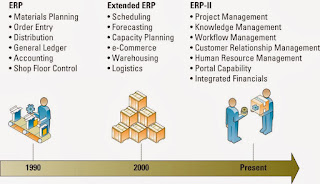The Evolution of ERP

ERP - The organization before ERP and after ERP
 |
| Before ERP |
 |
| After ERP |
Integrating SCM, CRM and ERP
- SCM, CRM and ERP are the backbone of e-business
- Integration allows the unlocking of information to make it available to any user, anywhere, anytime.
- General audience and purpose of SCM, CRM and ERP.
Integration Tools
- Many companies purchase modules from an ERP vendor, an SCM vendor, and a CRM vendor and must integrate the different modules together.
- Middleware - several different types of software which sit in the middle of and provide connectivity between two or more software applications
- Enterprise application integration (EAI) middleware - packages together commonly used functionality which reduced the time necessary to develop solutions that integrate applications from multiple vendors
- Data points where SCM, CRM, and ERP integrate
Enterprise Respurce Planning (ERP)
- ERP systems must integrate various organization processes.
- Flexible - must be able to quickly respond to the changing needs of the organization
- Modular and open - must have an open system architecture, meaning that any module can be interface, with or detached whenever required without affecting the other modules.
- Comprehensive - must be able to support a wide range of businesses
- Beyond the company - must support external partnerships and collaboration efforts.
- ERP is a logical solution to the mess of incompatible applications that had sprung up in most businesses
- ERP addresses the need for global information sharing and reporting
- ERP is used to avoid the pain expense of fixing legacy systems



Comments
Post a Comment